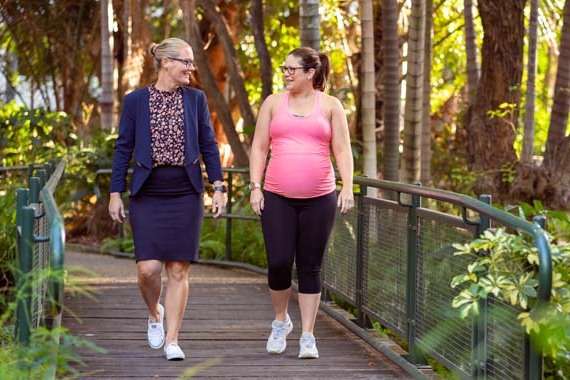Description
- Physical Activity Guidelines for Pregnancy
Evidence-based Physical Activity Guidelines for Pregnancy aim to provide best practice recommendations for pregnant women on physical activity during pregnancy and in the postpartum period. - Physical activity/exercise screening toolkit for pregnant women
User-friendly, evidence-based resource to help guide and support health professionals in providing physical activity/exercise advice to pregnant women.
Partners
- Physical Activity Guidelines for Pregnancy
The Australian Government Department of Health, University of Queensland. - Physical activity/exercise screening toolkit for pregnant women
University of Queensland, Exercise and Sports Science Australia (ESSA), Exercise is Medicine, Fitness Australia and Sports Medicine Australia (SMA).
Impact
Very few women are currently sufficiently active for health benefits. These resources provide evidence-based recommendations that pregnant women and health professionals can rely on to offer safe and appropriate physical activity/exercise guidance. Physical activity during pregnancy has health benefits for both the mother and child.
It is associated with fewer pregnancy conditions, including gestational diabetes and gestational hypertension. Active women are also more likely to gain an appropriate amount of weight during pregnancy and less likely to experience excessive gestational weight gain than those who are not active. These benefits have significant implications for the health of future generations.
Dr Melanie Hayman (CQU) and Professor Wendy Brown (UQ)
The Australian Government recently released a set of Physical Activity Guidelines for Pregnancy, which were co-developed by CQUniversity researcher Dr Melanie Hayman and eight others.
The aim of these guidelines is to provide evidence-based best practice recommendations on physical activity/exercise during pregnancy for Australian women and those who provide healthcare during pregnancy.
As such, these guidelines should be used to encourage women to achieve the levels of physical activity/exercise that are recommended for optimal health during pregnancy and in the postpartum period; and provide health professionals with evidence-based guidance on optimal physical activity behaviours during pregnancy and in the postpartum period.
Dr Hayman states that there is strong evidence that shows physical activity/exercise during pregnancy and the postpartum period is safe, has health benefits for the woman and her unborn child, and reduces the risks of some pregnancy-related complications, which is why Dr Hayman recommends that all women without contraindications should aim to meet the Australian national physical activity and sedentary behaviour guidelines.
Australia's national physical activity and sedentary behaviour guidelines
- Be active on most, preferably all, days every week.
- Accumulate two and a half to five hours of moderate-intensity physical activity or one and a quarter to two and a half hours of vigorous physical activity, or an equivalent combination of both moderate and vigorous activities each week.
- Do muscle-strengthening activities on at least two days each week.
- Minimise the amount of time spent in prolonged sitting.
- Break up long periods of sitting as often as possible.
'Pregnant women should also do pelvic floor exercises during and after pregnancy,' advised lead researcher Professor Wendy Brown from the University of Queensland.
Professor Brown also suggests that women who were active before pregnancy can continue with physical activity during pregnancy, and if inactive before pregnancy, women should start slowly and build up their activity to meet the recommendations.
'Doing any physical activity is better than none, and all physical activity counts,' says Professor Brown.
In addition to these recommendations, the research team advises that modifications to physical activity may be required to accommodate the physical changes that occur as the pregnancy progresses.
The team recommends women who have any concerns (including warning signs and contraindications) seek advice from a qualified health professional.
The guidelines also acknowledge the important role health professionals play in the prenatal care of women by stating that they actively engage in shared decision-making about women's physical activity during and after pregnancy and recommend that all health professionals who provide care during pregnancy be familiar with contraindications, signs and symptoms which suggest that physical activity should be modified or avoided.
In acknowledging the role of the health professional in prenatal care, Dr Hayman also led the development of an Australian physical activity/exercise screening tool.
The screening tool was created to help guide and support health professionals in providing physical activity/exercise advice to pregnant women.
This screening tool is evidence-based and aligns with the newly released Australian Department of Health Physical Activity During Pregnancy Guidelines. It is user-friendly and consists of a simple three-stage process. Importantly, the tool involves the screening of contraindications to guide exercise behaviours appropriately and safely among pregnant women.
The screening tool helps to guide the physical activity/exercise behaviours of pregnant women. It details how much and what types of physical activity a pregnant woman should or shouldn't do, as well as what intensity of exercise they should aim for. The tool provides indications for stopping exercise, consulting a health professional, and additional safety precautions.
Peak industry bodies, including Exercise and Sports Science Australia (ESSA), Exercise is Medicine, Fitness Australia and Sports Medicine Australia (SMA), were involved in the screening tools' development and have endorsed the tool.
Connect with CQUniversity
At CQUniversity we know the value of our connections locally and around the world. Our partnerships help us create opportunities, deliver solutions and change lives. From time to time, we share our Connections Count update, where we share our highlights, including research impact stories like the ones below. Sign up to become one of our valued connections.



